Personal wellness company WW (NASDAQ:WW) reported Q1 CY2024 results exceeding Wall Street analysts' expectations, with revenue down 14.6% year on year to $206.5 million. The company expects the full year's revenue to be around $845 million, in line with analysts' estimates. It made a GAAP loss of $4.39 per share, down from its loss of $1.68 per share in the same quarter last year.
WW (WW) Q1 CY2024 Highlights:
- Revenue: $206.5 million vs analyst estimates of $199.4 million (3.6% beat)
- EPS: -$4.39 vs analyst estimates of -$0.55 (-$3.84 miss due to a one-time franchise rights acquired impairment charge of $258 million)
- The company reconfirmed its revenue guidance for the full year of $845 million at the midpoint
- The company lowered its operating profit for the full year of a $159 million LOSS at the midpoint
- Gross Margin (GAAP): 66.7%, up from 57.1% in the same quarter last year
- Free Cash Flow was -$40.84 million, down from $7.50 million in the previous quarter
- Members: 3.3 million
- Market Capitalization: $144.9 million
Formerly known as Weight Watchers, WW (NASDAQ:WW) is a wellness company offering a range of products and services promoting weight loss and healthy habits.
WW began as a weight loss-focused organization with Weight Watchers and has since rebranded into a comprehensive wellness brand. The company originally gained traction through its approach to weight management, combining dietary advice with group support meetings. This approach provided a community and accountability that differentiated it from other diet programs.
Initially, WW's member growth was fueled by in-person group meetings and public speaking events, enticing members to join. The company then expanded by franchising the Weight Watcher program to its graduates.
Today, WW's products include cookbooks, prepared food lines, and more, catering to a broader range of consumers. Its offerings are primarily subscription-based, and customers can participate both digitally and in person, receiving individualized support and coaching. WW also generates income from branded services and products, such as magazines, food guides, and licensing fees.
Specialized Consumer Services
Some consumer discretionary companies don’t fall neatly into a category because their products or services are unique. Although their offerings may be niche, these companies have often found more efficient or technology-enabled ways of doing or selling something that has existed for a while. Technology can be a double-edged sword, though, as it may lower the barriers to entry for new competitors and allow them to do serve customers better.
WW's fitness and wellness peers include BODi (NYSE:BODY), MyFitnessPal, Noom, Cult.fit, and Trainerize.Sales Growth
A company’s long-term performance can give signals about its business quality. Even a bad business can shine for one or two quarters, but a top-tier one may grow for years. WW's revenue declined over the last five years, dropping 10.3% annually. 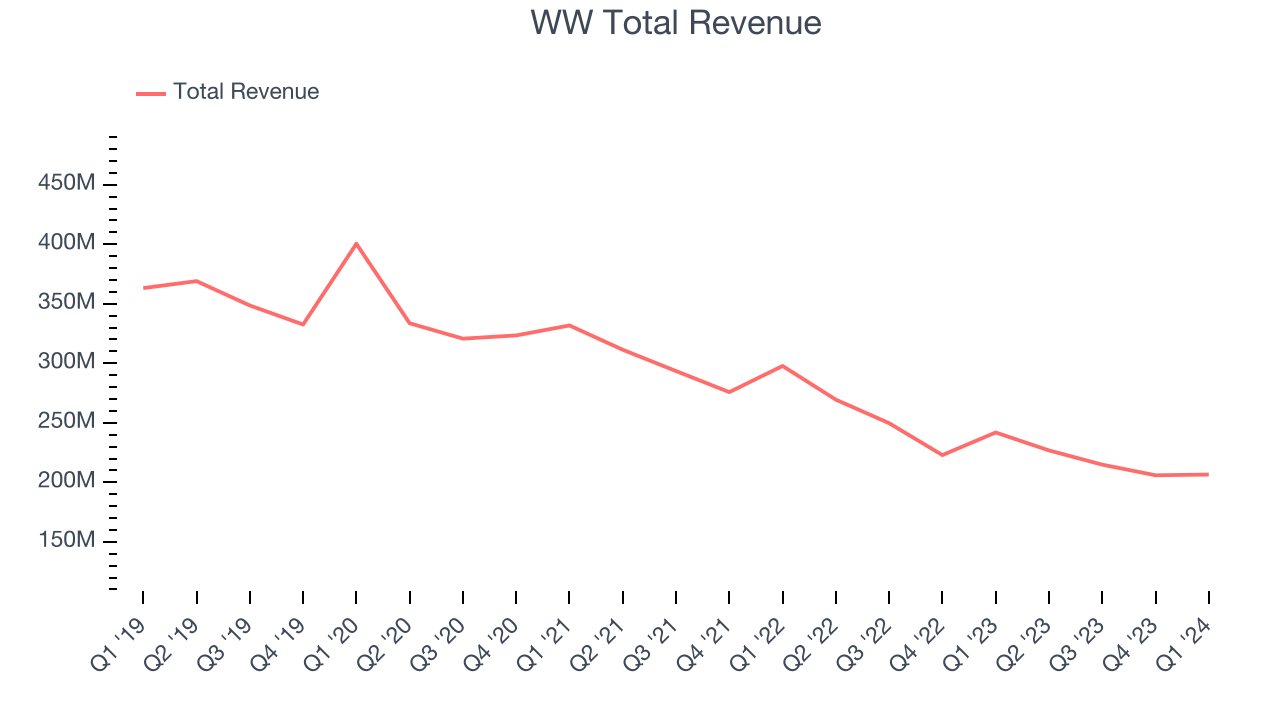 Within consumer discretionary, a long-term historical view may miss a company riding a successful new product or emerging trend. That's why we also follow short-term performance. WW's recent history shows its demand has decreased even further as its revenue has shown annualized declines of 14.9% over the last two years.
Within consumer discretionary, a long-term historical view may miss a company riding a successful new product or emerging trend. That's why we also follow short-term performance. WW's recent history shows its demand has decreased even further as its revenue has shown annualized declines of 14.9% over the last two years.
This quarter, WW's revenue fell 14.6% year on year to $206.5 million but beat Wall Street's estimates by 3.6%. Looking ahead, Wall Street expects sales to grow 1.8% over the next 12 months, an acceleration from this quarter.
Operating Margin
Operating margin is an important measure of profitability. It’s the portion of revenue left after accounting for all core expenses–everything from the cost of goods sold to advertising and wages. Operating margin is also useful for comparing profitability across companies with different levels of debt and tax rates because it excludes interest and taxes.
Given the consumer discretionary industry's volatile demand characteristics, unprofitable companies should be scrutinized. Over the last two years, WW's high expenses have contributed to an average operating margin of negative 29.4%.
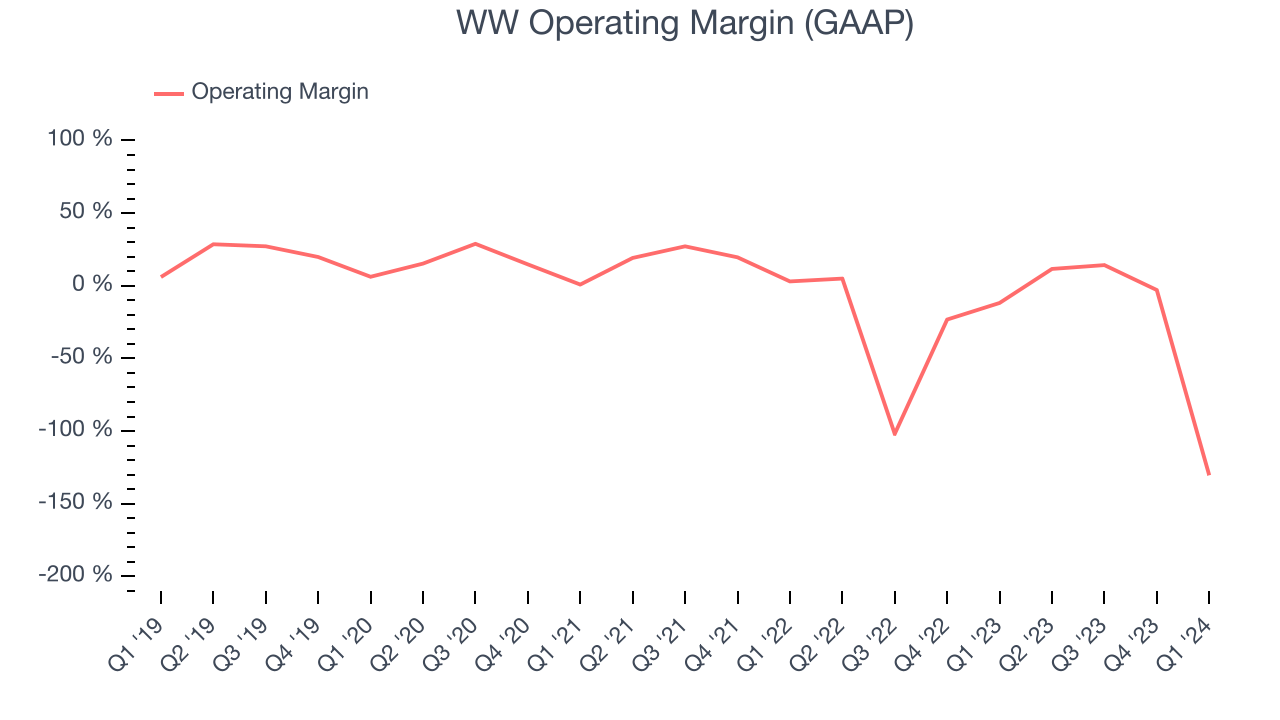
This quarter, WW generated an operating profit margin of negative 130%, down 118.6 percentage points year on year. This was due to a one-time franchise rights acquired impairment charge of $258 million.
Over the next 12 months, Wall Street expects WW to become profitable. Analysts are expecting the company’s LTM operating margin of negative 25.6% to rise to positive 13.1%.
EPS
Analyzing long-term revenue trends tells us about a company's historical growth, but the long-term change in its earnings per share (EPS) points to the profitability and efficiency of that growth–for example, a company could inflate its sales through excessive spending on advertising and promotions.
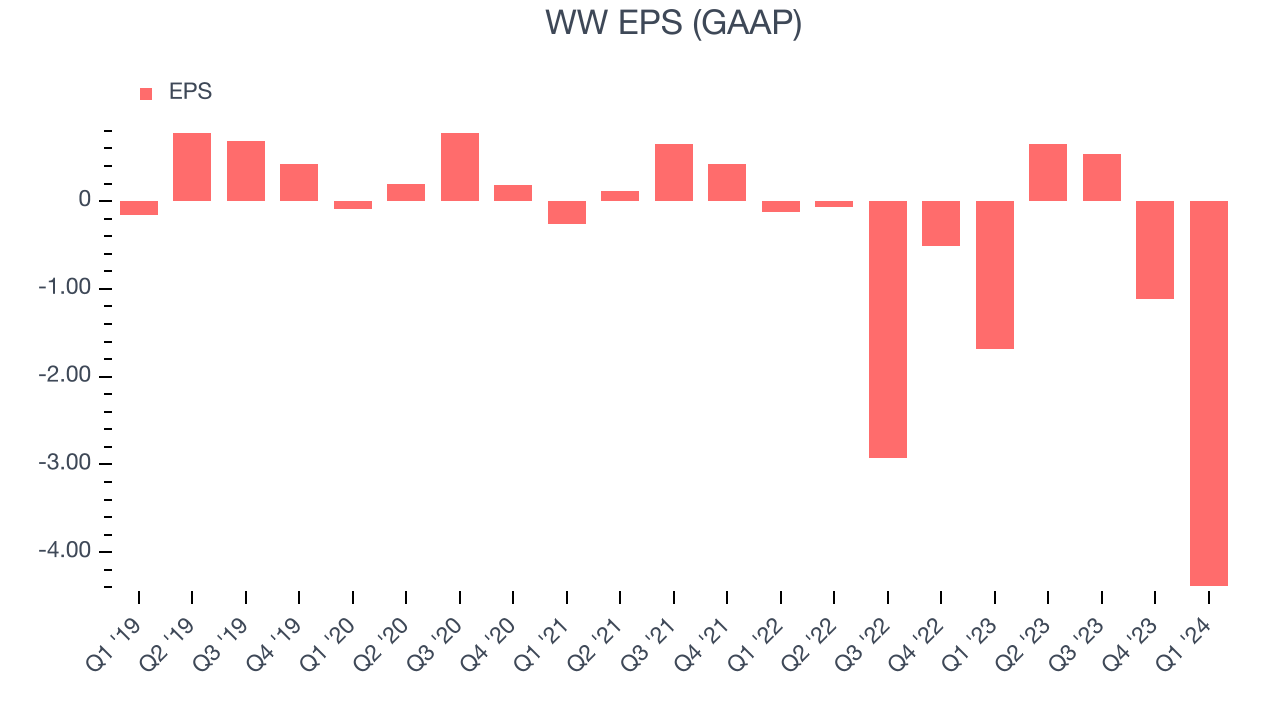
Over the last five years, WW's EPS dropped 274%, translating into 30.2% annualized declines. We tend to steer our readers away from companies with falling EPS, where diminishing earnings could imply changing secular trends or consumer preferences. Consumer discretionary companies are particularly exposed to this, leaving a low margin of safety around the company (making the stock susceptible to large downward swings).
In Q1, WW reported EPS at negative $4.39, down from negative $1.68 in the same quarter last year. This was due to a one-time franchise rights acquired impairment charge of $258 million. This print unfortunately missed analysts' estimates. Over the next 12 months, Wall Street is optimistic. Analysts are projecting WW's LTM EPS of negative $4.31 to reach break even.
Cash Is King
Although earnings are undoubtedly valuable for assessing company performance, we believe cash is king because you can't use accounting profits to pay the bills.
Over the last two years, WW has shown mediocre cash profitability, putting it in a pinch as it gives the company limited opportunities to reinvest, pay down debt, or return capital to shareholders. Its free cash flow margin has averaged 2.7%, subpar for a consumer discretionary business.
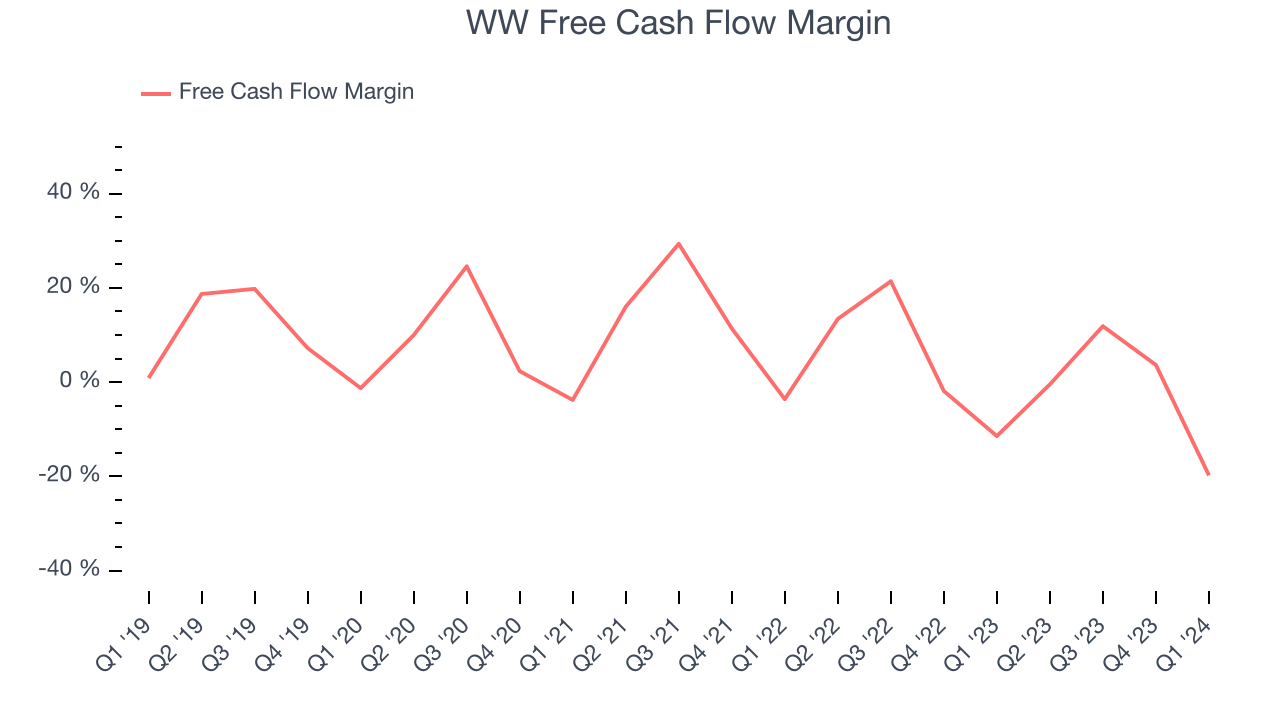
WW burned through $40.84 million of cash in Q1, equivalent to a negative 19.8% margin, reducing its cash burn by 47.4% year on year.
Return on Invested Capital (ROIC)
EPS and free cash flow tell us whether a company was profitable while growing revenue. But was it capital-efficient? A company’s ROIC explains this by showing how much operating profit a company makes compared to how much money the business raised (debt and equity).
WW's five-year average return on invested capital was 0.5%, somewhat low compared to the best consumer discretionary companies that pump out 25%+. Its returns suggest it historically did a subpar job investing in profitable business initiatives.
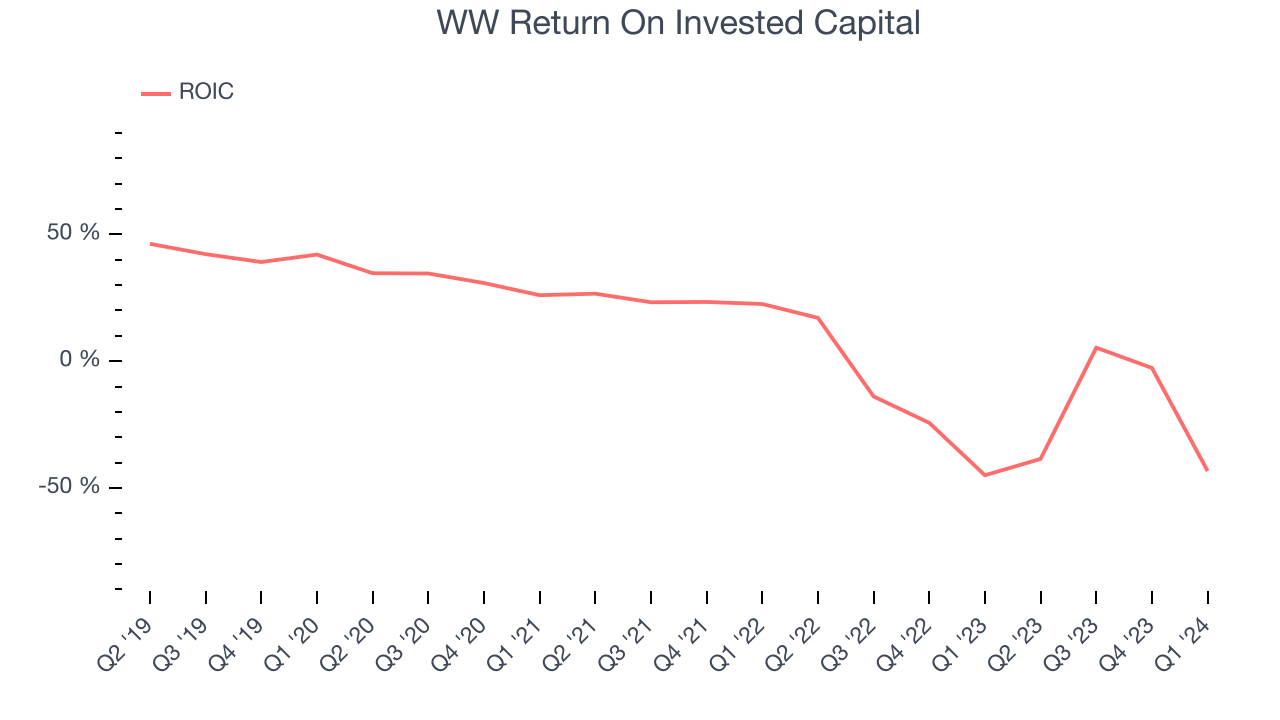
The trend in its ROIC, however, is often what surprises the market and drives the stock price. Unfortunately, WW's ROIC significantly decreased over the last few years. Paired with its already low returns, these declines suggest the company's profitable business opportunities are few and far between.
Balance Sheet Risk
As long-term investors, the risk we care most about is the permanent loss of capital. This can happen when a company goes bankrupt or raises money from a disadvantaged position and is separate from short-term stock price volatility, which we are much less bothered by.
WW's $1.49 billion of debt exceeds the $66.62 million of cash on its balance sheet. Furthermore, its 10x net-debt-to-EBITDA ratio (based on its EBITDA of $141.7 million over the last 12 months) shows the company is overleveraged.
At this level of debt, incremental borrowing becomes increasingly expensive and credit agencies could downgrade the company’s rating if profitability falls. WW could also be backed into a corner if the market turns unexpectedly – a situation we seek to avoid as investors in high-quality companies.
We hope WW can improve its balance sheet and remain cautious until it increases its profitability or reduces its debt.
Key Takeaways from WW's Q1 Results
It was good to see WW beat analysts' revenue expectations this quarter. On the other hand, its operating margin missed and its EPS fell short of Wall Street's estimates, but this was due to a one-time franchise rights acquired impairment charge of $258 million. The stock is up 2.1% after reporting and currently trades at $1.93 per share.
Is Now The Time?
WW may have had a tough quarter, but investors should also consider its valuation and business qualities when assessing the investment opportunity.
We cheer for all companies serving consumers, but in the case of WW, we'll be cheering from the sidelines. Its revenue has declined over the last five years, but at least growth is expected to increase in the short term. And while its projected EPS for the next year implies the company's fundamentals will improve, the downside is its declining EPS over the last five years makes it hard to trust. On top of that, its relatively low ROIC suggests it has historically struggled to find compelling business opportunities.
WW's price-to-earnings ratio based on the next 12 months is 43.4x. While we've no doubt one can find things to like about WW, we think there are better opportunities elsewhere in the market. We don't see many reasons to get involved at the moment.
Wall Street analysts covering the company had a one-year price target of $6.43 per share right before these results (compared to the current share price of $1.93).
To get the best start with StockStory, check out our most recent stock picks, and then sign up for our earnings alerts by adding companies to your watchlist here. We typically have the quarterly earnings results analyzed within seconds of the data being released, and especially for companies reporting pre-market, this often gives investors the chance to react to the results before the market has fully absorbed the information.
